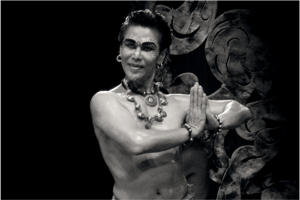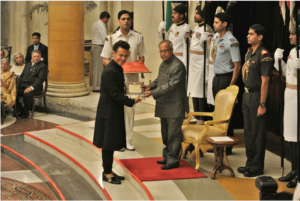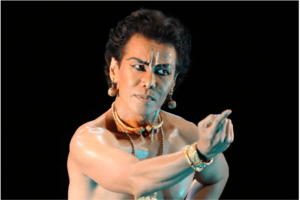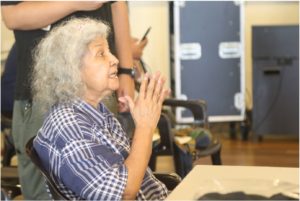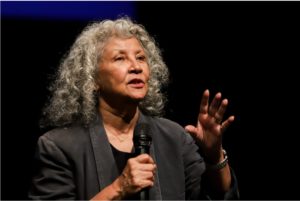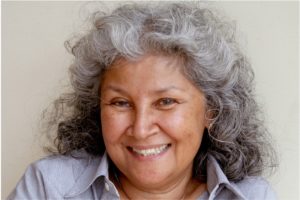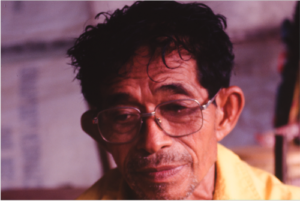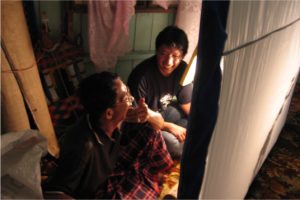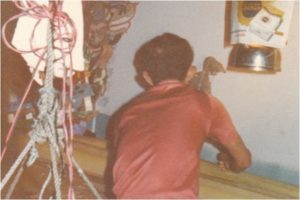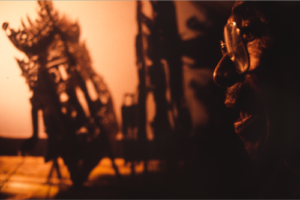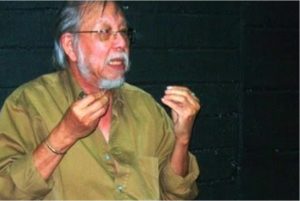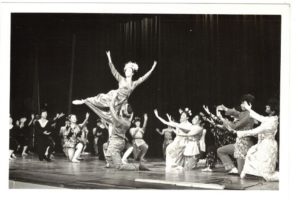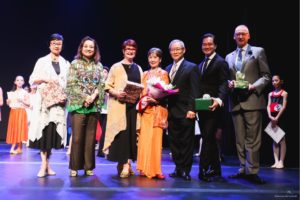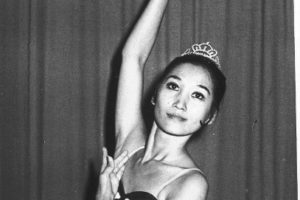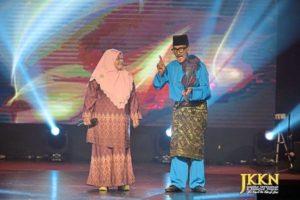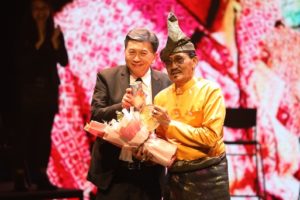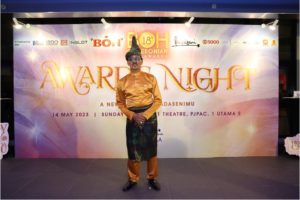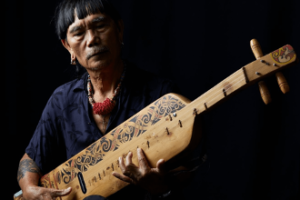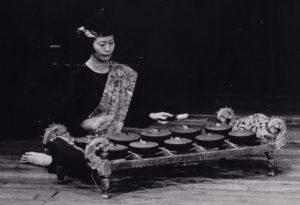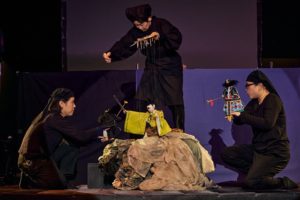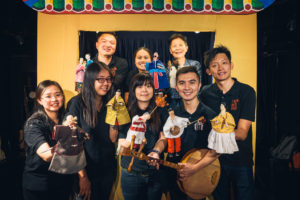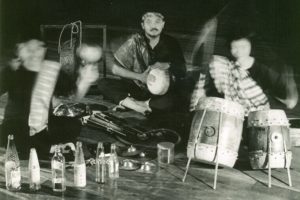The BOH Cameronian Arts Awards Lifetime Achievement Award highlights Malaysians/Malaysian born individuals or organizations who made their marks in the international arena with their artistic vision and excellence.
1st BOH Cameronian Arts Awards
Krishen Jit
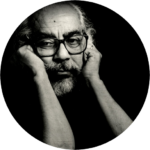
Krishen Jit (1939-2005) was one of Southeast Asia’s most influential theatre practitioners, a pioneer in shaping the identity of post-colonial theatre in Malaysia, and a founder member of Five Arts Centre. Trained as a historian and renowned for his eclectic, experimental style of theatre which fused traditional with contemporary forms, Krishen created performances that emphasised the politics of staging difference in multicultural Malaysia. His directorial career spanned over 35 years, during which he formed valuable creative partnerships with leading Malaysian and Singaporean playwrights such as Usman Awang, Syed Alwi, Dinsman, K.S. Maniam, Kee Thuan Chye, Leow Puay Tin, David Henry Hwang, Dick Lee, Kuo Pao Kun, Lloyd Fernando, Jit Murad, Huzir Sulaiman, and Stella Kon.
Krishen’s productions were performed internationally, touring to the Philippines, Japan, Hong Kong, Egypt, Germany, Australia, and the UK. In later years, Krishen also became very active in Singaporean theatre, working with companies such as TheatreWorks, Practice Performing Arts, W!ld Rice, and Action Theatre.
As a scholar, cultural critic, and public intellectual, Krishen Jit defied the boundaries of language, genre, and discipline – making his body of writings on theatre and performance an indispensable resource in the historicising and structuring of arts practice in Malaysia and the region. His weekly column Talking Drama with Utih ran for 22 years in the New Straits Times, and his writings have been compiled in two collections – Membesar Bersama Teater and Krishen Jit: An Uncommon Position. In 2003, Krishen was honoured with the inaugural Lifetime Achievement Award at the first BOH Cameronian Arts Awards in Kuala Lumpur.
Click here to read more on Krishen Jit written by Leow Puay Tin
2nd BOH Cameronian Arts Awards
Datuk Ramli Ibrahim

An accomplished ballet, modern and Indian classical dancer, Ramli Ibrahim has performed internationally for four decades. As the artistic director of Sutra Dance Theatre, Ramli has choreographed stunning works and nurtured some of the brightest dance talents from Malaysia.
Since his return to Malaysia more than thirty-five years ago, he has been instrumental in transforming the dance scene in Malaysia by boldly charting new paths establishing odissi as a widely appreciated dance form in Malaysia. Simultaneously, Ramli has contributed to the establishment of Malaysian contemporary modern dance through the creation of a strong body of original works, which defines ‘modernity’ from Asian perspectives.
Ramli Ibrahim has been honoured with many awards, the most recent being the Sangeet Natak Akademi award (2011) and the Padma Shri award (2018) from India and a Datukship (2013), Perdana Award (2019) and the Lifetime Arts Achievement Award (2019) from Malaysia. To Ramli Ibrahim “Dance is a celebration and liberation of the body, mind and soul.”
3rd BOH Cameronian Arts Awards
Datuk Faridah Merican
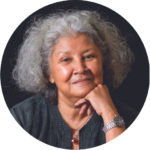
Known as the First Lady of Malaysian Theatre, Faridah’s early acting credits include such plays as ‘Lela Mayang’, ‘Tok Perak’, ‘Uda dan Dara’ and ‘Alang Rentak Seribu’, works that defined the Malaysian theatre in the 60s and 70s, and determined the direction that theatre would take in the next few decades.
In the early 60s, she joined Radio and TV Malaysia. Simultaneously, she was involved in the formative years of Malaysian Advertising, and served on the Board of Ogilvy & Mather for several years. She also sits on the board of several other institutions.
In 1989, Faridah co-founded The Actors Studio with her husband Joe Hasham OAM. In June of 2003, floods destroyed the entire complex of The Actors Studio in Plaza Putra, Dataran Merdeka. Out of that devastation, Faridah’s ‘nothing is impossible’ attitude generated yet another ground-breaking event – the birth of The Kuala Lumpur Performing Arts Centre, set up by the YTL Group, Yayasan Budi Penyayang and The Actors Studio.
Over the years, Faridah has been awarded the Ahli Mangku Negara in 1973, the Darjah Johan Negeri in 2001, the Johan Setia Mahkota in 2004, the BOH Cameronian Lifetime Achievement Award. In 2005, Faridah was conferred the ‘Darjah Dato’ Paduka Tuanku Ja’afar by the Yang Di-Pertuan Besar of Negeri Sembilan on the occasion of His Highness’ 83rd Birthday. The following year, she received an Honorary Master of Letters at University Sains Malaysia’s 35th Convocation. Finally in 2014, Faridah received the Outstanding Achievement award under the Arts, Culture and Entertainment category from the Inaugural Malaysian Women of Excellence Awards. In 2011, she co-founded the Performing Arts Centre of Penang (penangpac) which operated until 2022. Faridah now sits on The Laureate Advisory Board.
She was awarded an Honorary Doctorate in the Arts by Taylor’s University in 2018. Faridah is currently the Adjunct Professor & Programme Development Director of TUTAS, Malaysia’s first performing arts conservatory degree programme by The Actors Studio and Taylor’s University..
4th BOH Cameronian Arts Awards
Dalang Dollah Baju Merah
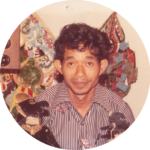
Abdullah bin Ibrahim, better known as Dalang Dollah Baju Merah, was one of the most popular and revered dalang in the Wayang Kulit tradition of Kelantan. He was among the last shadow puppeteers of Kelantan truly representative of a formal tradition in wayang practice. Initially regarded as a dalang budak (child prodigy), he commenced formal apprenticeship in wayang tradition at the age of 15 under the tutelage of a renowned older dalang—Dol Sabok. Throughout the 1960s and 1970s, Dollah Baju Merah led an itinerant wayang troupe, performing in the various districts and regions of Kelantan. Frequently emerging as juara dalang (champion dalang) in main tewas (dalang duels), he gained a reputation for being a particularly skilled, sensitive and provocative puppeteer.
Following the ban imposed on wayang by the PAS-led government of Kelantan in 1990, Dalang Dollah Baju Merah was forced to abandon his troupe, forsake performance and venture to Singapore, where he worked as an illegal menial labourer for two years. Upon his return to Kelantan, he rented a small rubber patch and cultivated rubber for a living.
Despite the proscription of his art form and physical infirmity, Dalang Dollah Baju Merah continued to practise and perform wayang in collaboration with PUSAKA until his demise. Dalang Abdullah bin Ibrahim passed away on 27th September 2005 at the age of 67.
Bio of Dalang Dollah Baju Merah written by Eddin Khoo, PUSAKA
5th BOH Cameronian Arts Awards
Datuk Syed Alwi
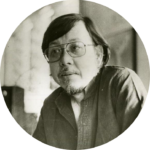
Dato Syed Alwi Syed Hassan is Malaysia's National Laureate, born in Taiping, Perak. He studied at the University of Minnesota, United States of America in the field of theater and journalism and was the first Malay child to continue his studies abroad in the field of theater.
Dato Syed Alwi received a John D. Rockefeller III Fund Scholarship to study current theater and film developments in America between April and June 1980. In Malaysia, Dato Syed Alwi had worked with RTM, TV3 and NTV7 as a manager, producer, actor, writer and director in addition to having worked with Film Negara, Panggung Negara, Academy of Arts, Heritage and Culture, University of Malaya and the United Nations Information Office.
He was considered to be a prominent figure who raised the dignity of the homeland’s theater from the primitive and aristocratic style to a more contemporary style. And was famous for his theater of two eras, namely the colonial era and the era of independence, and produced many works that were strong and had an impact, especially in discussing issues related to the Malay race.
Dato Syed Alwi was the founder of Malayan Art Theater Group (Malayan Art Theater Group) in 1951, which later turned into Malaysian Art Theater Group.
The Malaysian government gave the National Art Award on 19 September 2002, which is the highest award and recognition of the government to the country’s art activists.
6th BOH Cameronian Arts Awards
Professor Ghulam Sarwar Yusuf

Prof Ghulam-Sarwar Yusuf was an academic and writer, an expert in traditional Malay and South-East Asian theatre as well as one of the leading writers of Malaysian English Literature.
Hailing from Taiping, Perak Ghulam-Sarwar Yousof completed his primary and secondary education at King Edward VII School in his hometown, before proceeding to the University of Malaya in Kuala Lumpur, where he majored in English, with a minor in Islamic Studies.
Given the opportunity to go for further studies in theatre under the university’s Academic Staff Training Scheme, Ghulam-Sarwar went to Honolulu in 1972 on a grant from the East-West Centre, entering directly into the PhD programme of the University of Hawaiʻi Department of Drama and Theatre. He obtained his PhD in 1976 with a dissertation on the ancient mak yong dance theatre under the supervision of the renowned Asian theatre scholar, James R Brandon. Ghulam-Sarwar’s was to be the world’s first ever doctorate on any of the Malay performing arts.
In 1976, Ghulam-Sarwar served as Head of the Performing Arts programme and Associate Professor, until 1995. In 2009 he joined the English Department of the International Islamic University of Malaysia (IIUM) in Kuala Lumpur as Senior Academic Fellow.
He had participated actively in various theatre and cultural programmes involving international troupes during the annual Festival of Penang, as well as on preservation and conservation of traditional heritage. Prof Ghulam-Sawar carved for himself a niche as one of the world’s leading researchers on traditional Southeast Asian theatre, as well as related subjects such as Asian epics, folk traditions of the arts and shamanic rituals through his unstinting
forays into the field in almost all countries of the region. For the first time ever, through his efforts courses in traditional Malay and Southeast Asian genres such as the shadow play (wayang kulit), the mak yong dance theatre and bangsawan were offered in any Malaysian university. He prepared the official nomination papers on behalf of the Malaysian Ministry of Culture for submission to UNESCO to gain recognition for the mak yong dance theatre of Malaysia as an Item of the Oral and Intangible Heritage of Humanity in the year 2005.
Beyond Malaysia, his research efforts in Indonesia, the Philippines, mainland Southeast Asia, and India have provided new insights into relationships between particular shared genres such as the shadow play.
When it comes to creative writing Prof Ghulam-Sarwar, who worked with poetry, drama as well as short stories, emerged as one of Malaysia’s most prolific and original authors in the English language.
7th BOH Cameronian Arts Awards
Lee Lee Lan

Lee Lee Lan (née Tan Lee Lan) was born on the 16th of September 1944 in Brickfields Kuala Lumpur, Malaysia. At a young age, Lee Lee Lan began learning ballet at the encouragement of her older sisters. She received ballet instruction from dance academics Soonee Goh & Blossom Shek before moving on to the guidance and tutelage of British RAD ballet instructor Ethel Foxcrof at Le CoqDor Mansion. Foxcroft saw great potential in Lee Lee Lan, and offered her a full scholarship at her school when Lee Lee Lan and her family relocated to Melaka in 1957. For the next three years, Lee Lee Lan continued her ballet instruction with Ethel Foxcroft in Kuala Lumpur despite having to travel 3 hours by bus to and from Melaka.
After receiving her membership at the Royal Academy of Dance, London. Lee Lee Lan began holding ballet classes whilst studying for her Form 6 examinations in Kuantan. Despite a busy schedule, Lee Lee Lan continued to excel academically and was accepted into the University of Malaya. During the course of her university studies, she was involved in the University of Malaysia’s arts community, and choreographed for multiple musicals such as “West Side Story”, “Flower Drum Song”, “Progy & Bess” and “Show Boat”.
In conjunction with her choreographic involvement and studies, Lee Lee Lan continued teaching ballet in order to support herself. Her dedication to teaching and building a dance community allowed her to eventually establish her own ballet school, the “Federal Academy of Ballet” in 1967. On the side of building her school, Lee Lee Lan began choreographing and dancing for Malaysian TV, including Antara Empat Kaum series and touring the country with her “Federal Ballet Group”. The exposure garnered from these performances allowed the school to become one of the most prominent ballet schools in Malaysia. On the 4th of April 1989, Lee Lee Lan officially opened the school’s Headquarters which is home to one of the first Black Box Theatres in the area, famously known as the Fonteyn Studio Theatre.
In 1981, after a period at the Martha Graham School of Contemporary Dance in New York, Lee Lee Lan was inspired to embark on more personal and ambitious choreographies. Her ambitiousness and vision led to the choreography and performance of Soraya, a three – act ballet. Soraya was first premiered by the Federal Academy of Ballet and the Kuala Lumpur Symphony Orchestra in 1981 at Dewan Tunku Chancellor, University of Malaya. Later in 1982, Soraya had a royal premier and performed for the King of Malaysia, Sultan Ahmad Shah at the newly built Dewan Bandaraya Kuala Lumpur with an integral Orchestra Pit.
After success with Soraya, Lee Lee Lan continued to establish a name for herself as a choreographer by completing many choreographic works inspired by different genres, especially traditional dances, through dance groups and societies she established and was part of.
In 1984, Lee Lee Lan together with Tan Sri Lim Kok Wing formed the Kuala Lumpur Dance Theatre (KLDT), Malaysia’s first professional ballet and dance company. Lee Lee Lan choreographed many dances for the group which continued to promote her affluence and talent in the dance community. One notable performance was Lee Lee Lan’s choreographic work “See Not, Hear Not, Speak Not” which won the Saitama Choreographic Competition in Tokyo.
In 1985, Lee Lee Lan established the idea of building a dance society in Malaysia that promotes the awareness of dance in Malaysia as well as raise the standard of dance. In 1986, the “Dance Society of Malaysia” was registered and the Pro-Tem Committee became the first official committee under the founder Lee Lee Lan. Since its establishment, the dance society has organised competitions and workshops in Malaysia that focuses on raising the dance standard and raising awareness of dance in Malaysia.
In 1990, Lee Lee Lan became the Vice President of World Dance Alliance -Asia Pacific that spread information on dance, dance awareness programmes, dance research, dance workshops and dance performances amongst local dance enthusiasts, dancers, choreographers, critics and researchers. In 1994, Lee Lee Lan became part of the Committee of C.I.O.F.F (The International Council of Folklore Festival and Folk Arts Organisation) which is an official partner of UNESCO.
Due to her affluence and dedication towards the dance community of Malaysia, she was awarded the Avon Woman of Distinction Award Tan Sri Fatimah Woman for her leadership and entrepreneurship and the ISTD International Award in 1992. In 2008, Lee Lee Lan received the BOH Cameronian Lifetime Achievement Award.
By the mid-2000’s, Lee Lee Lan retired from ballet and chose to focus on teaching and running her ballet school alongside her children. On the 16th of May 2022, Lee Lee Lan sadly passed away at her home in Petaling Jaya. Despite Malaysia losing one of their greatest dance pioneers, her legacy and impact continues to live on through her teachers, students and The Dance Society of Malaysia.
8th BOH Cameronian Arts Awards
The Temple of Fine Arts

Knowing that the study of music, dance and drama can bring about a positive effect in the individual and the community, Swami Shantanand Saraswati, a Hindu monk from Rishikesh, established The Temple of Fine Arts. This was 1981, and he did it with the
support of two dance masters of that generation – Gopal Shetty and VK Sivadas. Together with their spouses, Ratha Shetty and Vatsala Sivadas, they conducted classes in the humblest of conditions – a cement floor measuring no more than 35×35 ft under a spare zinc and asbestos roof, with the gust of city traffic winds blowing in over the Klang River in Brickfields, Kuala Lumpur.
Soon after, he garnered the support of Carnatic violin and flute guru Valambikai Rajagopalan and Carnatic vocal master Nagaswami Bhagavathar, beloved as the DJ for the Tamil music segment on RTM every Sunday. They were later joined by Sivamani Chelliah and Sarojini Thanabalasingam as vocal teachers. The Temple of Fine Arts rang with children’s voices and their stamping feet.
This was, in fact, a culmination of 10 years’ work by Swamiji among those who listened to his talks on life and spirituality.
The aim of the TFA was to guide Malaysian youth to discover the cultural and artistic wealth of their forefathers and to make it relevant for themselves and for generations to come.
Audacity is the word to describe what came after. While students were taught the traditional music and dance styles, Swamiji launched TFA’s first foray into dance drama productions with Legend of Mahsuri in 1985. He followed this with Jonathan Livingston Seagull (1986), Swan Lake (1987) and Lady White Snake (1990). He recognized the rich cultural diversity in Malaysia and viewed that as an important factor in the affirmation, development, and fulfillment of the child’s potential. One would say that the community woke up to a new artistic force that challenged its own cultural boundaries.
Accompanying this unique thrust into the consciousness of the community, he declared that admission to these performances would be free – or audience members could pay whatever they wish. The response was spontaneous – full house at every performance. The audience did not just see a show; they saw courage, discipline, resourcefulness, trust, faith, endurance, team spirit and team work. And they would return with enthusiasm each year to witness that somewhat mysterious experience of beauty
commingled with joy that would come whenever inspiration is combined with selfless action.
In 1992, Swamiji topped what was done the previous years with The Ramayana – An Asian Confluence – a collation of different music, dance and costume traditions from the South and Southeast Asian regions to illustrate the powerful cultural influence that Rama’s story has on the region. When this was later toured to Chennai with a team of 120 cast and crew, it created a deep impression among art lovers there with its unprecedented scope and diversity.
More came after. Odissi Odyssey, a production in the Odissi dance style, which was later revised to become the full length Buddham Sharanam Gacchaami depicting the transformation of Emperor Ashoka. In that same year of 1994, this was followed, close on its heels, by A Midsummer Night’s Dream, with Shakespeare’s text played against an Indian setting. When this production was mounted in Chennai at the Kamraj Auditorium
in 1999, it featured real horses coming down the aisle, and onstage, a trumpeting elephant welcoming the royal couple.
In 1995, Taj Mahal, inspired by Princess Diana’s visit there, presented the love story of Shah Jehan and his Mumtaz in the Kathak style of dance. And next was Sundera Keralam featuring the myths, legends, music, and dance traditions of the state of Kerala. A music production Nadopasana presented the teachers and students of the entire music department. Kalidasa’s tragic love story Shakuntala (1997) was toured, like the others, to Singapore, Australia, and India. The music department came to the fore again later, this time with Naad Brahma, featuring a full orchestra of Indian instruments and voices.
These productions had the positive effect of raising the artistic and cultural awareness of the community. And this good effect could be observed in other cultural and artistic communities in the country as well. As a people, we were all consciously contributing to a coherent stream of artistic voices.
In 2002, TFA produced their version of Butterfly Lovers, the love story of Liang Shanbo and Zhu Yingtai, followed by Krishnaarpanam, a full dance production in Bharatanatyam with a live musical ensemble. Other productions joined the list; Bhamane Satyabhama in Kuchipudi, Transcendance in Odissi, and a flurry of intimate theatrical productions came to the fore – The Crow, The Mole and The Tortoise, a devised children’s play based on stories from Vishnu Sharma’s Panchatantra, Qismet, another devised play based on stories from the Arabian Nights, or 1001 Nights, The Merchant of Venice with Shylock played by an actress.
The year 2005 saw TFA pushing their boundaries even further with Inside Out, its first and award-winning contemporary dance production presented by their exploratory, full time wing TFA Inner Space. In 2010, a colourful dance drama on the saint Meerabhai was presented.
A few years later, in 2014, the drama students featured in previous theatrical productions found the true test of their training in Chalo Shaadi Karenge, a full-length production on Shakespeare’s Taming of the Shrew, this time Bollywoodised! In that same year, the Shantanand Festival of Arts was created to bring together performing artists at home and abroad to share their diverse experiences in the practice of what they love the most.
In all these explorations of different themes and artistic styles from various sources, one thing was constant. This was the theme of love; love in different forms and expressions. An observer could easily discern, having witnessed these performances through the years, that the underlying message Swamiji intended to bring across through the Temple of Fine Arts artistic endeavours was that love is the bedrock from which all action, expression and events could spring, and that this is fundamental in all human experience. This was in fact, his effort to help TFA teachers, students and the community to explore, express and experience the seemingly simple motto of Love, Serve, Give.
18th BOH Cameronian Arts Awards
Datuk Baharim Mohd Sharip

Datuk Mohd Baharim Bin Mohd Sharip was born on 9th September 1944 in Kampung Bertam Ulu, Melaka. His talent in the field of art was inherited from his family. His father, a violonist together with his grandfather who is a Dondang Sayang singer. Datuk Mohd Baharim learned the art of Dondang Sayang from them until he became interested in dabbling in the art.
Proficient in playing the violin and other musical instruments since ten, his persistence in the art of Dondang Sayang led him to join establish the Kumpulan Cak Kun Cak. One of the achievements was his success in the Pesta Dendang Rakyat, managing to win the first place.
He received a recording offer at RTM Melaka and subsequently managed to record an album called ‘Mawar Biru’with a total of five albums successfully produced.
Datuk Baharim has also produced a large collection of Dondang Sayang poems which are estimated to reach almost two thousand verses. After the Kumpulan Cak Kun Cak, he revived a new group and name ‘Kenangan Mawar Biru’ and acted as the music leader.
Datuk Baharim is still active in performing, organizing music workshops and Dondang Sayang poems untill today.
19th BOH Cameronian Arts Awards
Mathew Ngau Jau

Mathew Ngau Jau, 72, stands as a towering figure in Malaysian arts and culture, a living testament to the enduring legacy of the Kenyah Ngorek people of Borneo and the enchanting melodies of the Sape’. With a career spanning decades, Mathew has not only preserved but also elevated the traditional art forms of his community, earning accolades and recognition both nationally and internationally.
His numerous awards include Malaysia National Heritage (2015), Sarawak State Art and Culture Figure (2016), Star Golden Hearts Award (2019), Hai-O Arts & Culture Grants Award for Lifetime Achievement (2022), and Anugerah Adiguru ASWARA (2022). His global performances have showcased the beauty of Kenyah culture. Through his performances, teachings and craftsmanship, he has breathed new life into ancient traditions, ensuring their relevance in a rapidly changing world. His impact extends beyond music, inspiring pride in cultural heritage and fostering resilience in communities.
For his outstanding contributions, Mathew Ngau Jau, “the Keeper of the Kenyah Ngorek Songs”, is truly deserving of this year’s BOH Cameronian Arts Awards’ Lifetime Achievement recognition.
20th BOH Cameronian Arts Awards
Professor Dr. Tan Sooi Beng

Tan Sooi Beng is known as a scholar-activist, an academic who not only conducts research and writes, but who is actively engaged to bring about change for the benefit of the people she works with and for the betterment of Malaysian society.
A Scholar
Tan Sooi Beng is Honorary Professor of Ethnomusicology at the School of Arts, Universiti Sains Malaysia (USM). She received her BA (Music) from Cornell University (Ithaca, NY), MA (Music) from Wesleyan University (Middletown, Connecticut), and Ph.D. (Music) from Monash University (Melbourne, Australia). She played a key role in the setting up of the School of the Arts at Universiti Sains Malaysia and developed the first BA (Music) programme in Malaysia that encompassed Western, Malaysian and World Music in the 1990s.
As a researcher, Tan has published many books and articles on the Malaysian performing arts. She is known for her seminal book Bangsawan: A Social and Stylistic History of Popular Malay Opera (Oxford University Press, 1993) that has motivated other international and local scholars to study the historical development of popular music of the Malay Archipelago. Other books that are often cited are the co-authored Music of Malaysia: Classical, Folk and Syncretic Traditions (Routledge 2017) and Longing for the Past, the 78 RPM Era in Southeast Asia (Dust-to-Digital, 2013), which won the joint SEM Bruno Nettl Prize, 2014. Through her historical research on the theatre and music traditions of Nusantara, she has shown the eclectic nature of the region’s cultures prior to the formation of nation states. This has inspired her compositions, community theatre productions and her search for Malaysian identities.
Tan is also lauded internationally for her efforts in decolonizing ethnomusicology and promoting alternative ways of knowledge production that privilege the tradition bearers. She plays an active role in furthering the study and sustainability of music and dance in the world as the first elected Asian woman President of the International Council for Traditions of Music and Dance (ICTMD), a scholarly organization in formal consultation with UNESCO (https://ictmusic.org/).
An Activist
As an educator and activist, Tan has attempted to make music education in Malaysia accessible and inclusive. As an advisor for the review of the Music Syllabus in Primary Schools and the formation of the Music Syllabus for Secondary Schools in Malaysia(Curriculum Development Centre, Ministry of Education, l993-2000), she pushed for the inclusion of Malaysian music in the syllabus.
To further decolonize music education in the 1990s, she conducted workshops for school teachers and students on Music of Sound (Muzik Bunyi-Bunyian) that inculcates the making of music by using everyday objects, parts of the body, and one’s voice. The methodology that includes site visits to collect sounds, conversations, folk songs and stories from the multiethnic communities, learning traditional instruments and collaborative compositions, encourages young participants to cross ethnic/cultural borders and to understand their cultural differences.
In 2000, Tan began to use the Music of Sound methodology in the creation of community theatre in Penang. In collaboration with artists from Ombak-Ombak ARTStudio and ARTSEd, she recreated the multiethnic histories of Penang through musical theatre such as Kisah Pulau Pinang (2006), Ronggeng Merdeka (2007), Kotai Penang (2008), Opera Pasar (2010), Ceritera Kebun Bunga (2011) and George Town Heboh – Streets Alive (2012). Following her research, these theatre productions transcend race by combining local languages, music, dance and theatre; they help young participants to recover a sense of place in Penang. See an example of the use of Music of Sound in the project Kisah Pulau Pinang.
As a composer and musician, Tan re-envisions the cultural aesthetics of multiethnic Malaysia by juxtaposing Malay, Chinese, Indian, and Western musical elements and instruments with topical Malaysian themes. Listen to her compositions based on the soundscapes of the coffeeshop in Penang and her gamelan composition Perubahan that was performed by Rhythm in Bronze and Hands Percussion at https://www.bfm.my/content/podcast/the-sound-of-malaysia-with-tan-sooi-beng
During the past eight years, Tan has been engaged in the revitalization of the endangered Potehi, the Hokkien glove puppet theatre in Penang. She gathered a group of young people to learn the art of puppet manipulation and the music from the Beng Geok Hong troupe, the oldest troupe in Penang. Known as Ombak Potehi, the group performs traditional and localized stories for the public. Watch the Potehi Revival in Penang here.

